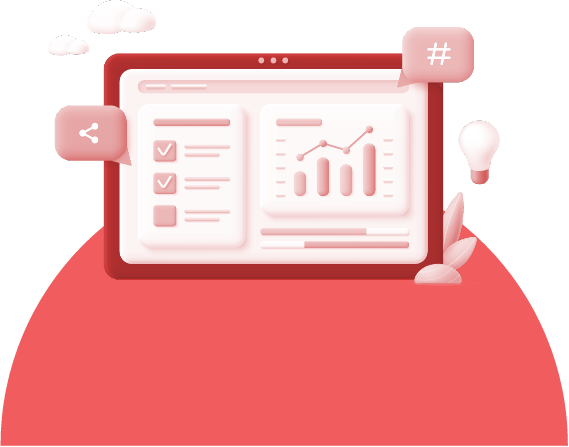Website Development Services – Professional Custom Web Development
Website development is all about creating online spaces that are user-friendly and visually appealing. This involves several aspects, including web design, content creation, client-side and server-side coding. They can be simple informational sites to complex e-commerce platforms, all depending on what you need. Website development helps to create online presences that are functional, look good, and tailored to specific business objectives.
Pros for Using
Website Development Services
Why hire the pros? Below are several reasons why businesses should consider it:
- Expert-crafted Websites: Businesses can benefit from high-quality, functional, and visually stunning websites built by pros with proven skills and experience. They’ll ensure your site meets industry standards while looking amazing.
- Your Vision, Brought to Life: Professional developers will work with you to craft a website that perfectly reflects your brand, targets the right audience, and achieves your business goals.
- Save Time & Money: Professionals streamline the process with their expertise, minimizing costly mistakes and delays.
- Top Search Rankings: Developers also build your site with SEO best practices in mind to maximize your reach and attracting new customers.
- Always Up-to-Date: In addition to that, developers will also continue to provide businesses with ongoing support to keep website secure, functional, and mobile-friendly on all devices, ensuring a smooth user experience.
What is
Website Development?
Basically, website development combines web design, content creation, and coding to craft websites that not only function well but look great too. These websites can range from simple informational pages to complex online stores depending on the need.
On top of prioritizing user experience (UX) with intuitive designs, website development also applies Content Management Systems (CMS) so that visitors can find great content with ease. Developers can also help e-commerce businesses create SEO-optimized stores to attract more customers.
This is often a team effort, with designers, developers, and content creators working together to bring your online vision to life. This collaborative effort empowers businesses to establish a strong online presence that attracts and engages their target audience.

Website Development Process
The website development process is a structured approach to crafting exceptional online experiences. Here is a breakdown of all its key stages:

Form a plan.
First, the website development team needs to outline project goals, target audiences, required features, and set a timeline to establish a clear roadmap for the website development process.
Create a wireframe.
Next, they need to visualize the website’s structure and layout through low-fidelity wireframes, while prioritizing user experience and information architecture.


Draft up a sitemap.
A draft hierarchical sitemap is drawn up to organize and interlink website pages to ensure seamless navigation and logical content flow.
Build the back-end of your website.
Developers then use programming languages frameworks like PHP, Ruby on Rails, or Node.js. to implement server-side logic (for inventory and suggestions), database integration, and functionality.


Build the front-end of your website.
There’s also your store front to design and with a strong focus on improving user experience with the help of HTML, CSS, and JavaScript for visually appealing and interactive web pages.
(Optional) Work with a CMS.
Although it is not a must, but utilizing a Content Management System (CMS) like WordPress or Drupal to streamline content creation, management, and website maintenance. Many CMS platforms offer built-in features like image galleries, contact forms, and SEO (Search Engine Optimization) tools, saving you time and money on additional development.


Acquire a domain name.
Then, to secure your online presence, register a unique and memorable domain name that aligns with your brand and website purposes.
Launch your site.
Finally, you can upload your completed website to a web server, conduct thorough testing to ensure no hiccups, and make it live for public access and engagement.

Why Should Your Business Use
Website Development Services?
Businesses should consider using professional website development services to gain:
- Expertise and quality assurance from skilled developers who are adhering to best practices
- Customized solutions tailored to their business needs with room for scalable growth
- Search engine optimization (SEO) for better online visibility and traffic.
- Responsive, mobile-friendly designs for optimal user experience across devices.
- A competitive edge with a strong, modern online presence that represents your unique brand
- A high-quality, tailored website aligned with your business objectives
Why Should Your Business Hire a Website Development Company?
Your business should hire a website development company to leverage their specialized expertise while saving time and costs. Outsourcing allows you to avoid the challenges of building an in-house team. These companies have professionals skilled in web design, UX, coding, and optimization to ensure your website meets industry standards.
They offer custom, tailored solutions that align with your business needs and brand. In addition, website development companies can also make allowances for enhancements to cater to future company growth. This saves a lot of resources and eliminates having to rebuild processes from scratch. More importantly, they provide much needed ongoing support and maintenance to keep your site secure, updated, and running smoothly.
By hiring professionals, you get a high-quality online presence optimized for your audience, which frees your own employees so they can focus on operations.
Front-End
Website Development Languages
Front-end development languages are the tools used to build the parts you actually see and interact with on a website. They’re what makes your site visually appealing and user-friendly. Here are some of the key languages used for this:

HTML
HTML is the foundation of any website and defines the content elements like headings, paragraphs, images, and links.

CSS
CSS controls the visual presentation of a website. It allows developers to style HTML elements with layout, colors, fonts, and even animations, creating a visually appealing user interface.

JavaScript
Adding user interactivity and dynamic website functionality is where JavaScript comes in. This powerful language enables features like form validation, pop-up windows, user interactions, and engaging animations to keep your target visitors engaged.

jQuery
jQuery is a popular library built on top of JavaScript that simplifies client-side scripting. It provides a concise syntax for Document Object Model (DOM) manipulation, event handling, and Asynchronous JavaScript And XML (AJAX) interactions, streamlining development processes.

React
For building complex user interfaces, React truly shines. This library utilizes a component-based architecture and virtual DOM for efficient rendering, making it a popular choice for modern web applications.
Back-End
Website Development Languages
On the other hand, back-end website development languages are responsible for server-side operations, such as handling user requests, interacting with databases, and implementing business logic. These languages work behind the scenes to power the functionality and data processing of websites and web applications.

Python
Python is a powerful programming language known for its versatility, simplicity, readability, and extensive libraries. Hence, it is a popular choice amongst developers for back-end web development, data analysis, and automation.
It is also relatively easy to learn, even for beginners, unlike some coding languages that look like gibberish.

PHP
PHP (Hypertext Preprocessor) is a server-side scripting language widely used for website development. Its strength lies in creating dynamic websites and web applications which uses strong integration with databases like MySQL. PHP can also build features like user logins, product searches, and online forms.

Ruby
Ruby is an object-oriented programming language known for its elegance and developer-friendliness. It is often used in website development through the Ruby on Rails framework.
Together, they act like a shortcut kit for developers, allowing them to build websites quicker without sacrificing quality.

Java
Java is also another powerful and platform-independent language that is widely used for developing large-scale enterprise applications thanks to its security, performance, and scalability. This includes back-end systems, web services, and APIs.
Java works on pretty much any computer system, making it a safe bet for building applications that need to function across different platforms.

C#
C# (also known as “C-sharp”) is a modern, object-oriented language developed by Microsoft that is primarily used for building Windows applications. This includes web services, and games, as well as back-end systems and cloud services.
However, developers can build native apps for Android, iOS, and Windows by using C# which makes for a seamless application across all devices.

Node.js
Node.js is a runtime environment that allows developers to use JavaScript for server-side tasks as well. This means they can build powerful features and services behind the scenes of a website, making it faster and more efficient.
Some Website Development Resources
Below are some helpful website development resources where both beginners and pros can find in-depth documentations, self-paced curriculum, hands-on exercises, and supportive communities:
Mozilla Developer Network (MDN)
- A comprehensive resource maintained by Mozilla, Firefox browser
- Provides extensive documentation, tutorials, and references for web development technologies such as HTML, CSS, JavaScript, and various APIs
- Regarded as a reliable and up-to-date source of information for web developers
FreeCodeCamp
- A nonprofit organization
- Offers a free, self-paced curriculum for learning web development
- Covers a wide range of topics, including HTML, CSS, JavaScript, React, Node.js, and various front-end and back-end frameworks
- Provides hands-on projects and a supportive community
Top 3
Web Development Courses
These courses are highly regarded for their comprehensive curriculum, from knowledgeable instructors who take on a more practical approach to teaching web development. These top 3 website development courses offer hands-on projects, and cover a wide range of technologies to equip learners with the skills needed to build modern, responsive, and scalable web applications.

The Complete Web Developer Course 2.0 by Rob Percival
- Available on Udemy
- Comprehensive course covering front-end and back-end web development
- Covers HTML, CSS, JavaScript, React, Node.js, MongoDB, etc
- Suitable for beginners, with no prior experience
- Hands-on projects and real-world examples
The Web Developer Bootcamp by Colt Steele
- Available on Udemy
- Highly rated and popular course for learning full-stack web development
- Covers HTML, CSS, JavaScript, Node.js, Express.js, React, and more
- Focuses on building real-world projects and practical skills
- Suitable for beginners to intermediate level


CS50’s Web Programming with Python and JavaScript
- Offered by Harvard University through edX
- Covers Python, JavaScript, and SQL
- Explores concepts like web frameworks, scalability, and security
- Suitable for beginners with some programming experience
Schedule A Website Development Consultation With Highground.asia To Get More Information About Our Website Development Services!
Ready to build your online presence? Schedule a website development consultation with Highground.asia today to learn more about our services!


